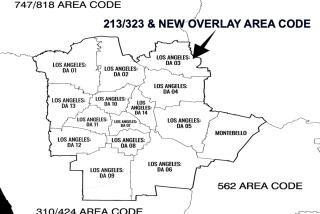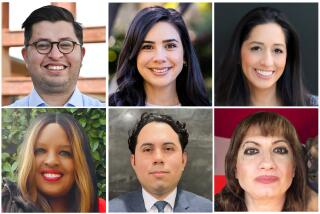Panel to Consider Overlay for 818 Calling Area
- Share via
In a decision that would affect hundreds of thousands of telephone users in the San Fernando Valley, state regulators on Aug. 5 will consider an area code overlay in the 818 calling area, officials said Thursday.
This week a state administrative law judge for the Public Utilities Commission recommended the overlay, rejecting an alternative plan to again divide the 818 code geographically.
Under the overlay proposal, all new phones in Valley homes and businesses would get the new area code, with the actual three-digit number to be determined later.
Also, all callers in the 818 area would have to dial the 818 code to other 818 phones--even if those phones are in the same building or next door.
“I think we should stop this proposal in its tracks,” said Assemblyman Wally Knox (D-Los Angeles), who has introduced legislation to put stricter controls on overlays. “What they call area code relief, we call area code chaos.”
The California Public Utilities Commission is scheduled to consider the proposal at its Aug. 5 meeting, said Kyle DeVine, a state public utilities spokeswoman.
A coalition of telecommunications companies including Pacific Bell, GTE and MCI are pushing for the changes, saying either an overlay or a new geographic area code is necessary to accommodate a surge in demand for additional telephone lines for computer modems, fax machines, pagers and cellular telephones.
Telecommunications providers project available numbers will be exhausted within the first few months of 2001.
But Chatsworth attorney Bill Powers, who estimates he makes 60 calls a day, says there is a better solution.
“What they need to do is create a situation where modems and cell phones have their own area code, rather than use this as an excuse to do an overlay,” Powers said. “It would be a pain in the neck and work its way down.”
Before an overlay can be implemented, DeVine said, the five-member PUC would require telecommunications company executives to submit documentation supporting their argument that there is a pressing demand for new telephone numbers in the 818 area code.
“The commission . . . is taking a more critical look at the industry’s claims that numbers are running out before it will authorize implementation of area codes,” DeVine said.
State regulators tried to alleviate the number crunch two years ago when they geographically split the 818 area code and created the 626 area code, which covers most of the San Gabriel Valley.
Nevertheless, phone companies and the North American Numbering Plan Administration asked the commission in February to consider two proposals to once again break up the 818 calling area.
DeVine said Administrative Law Judge Tom Pulcifer on Wednesday rejected an alternative plan that would have avoided the overlay by instituting a new area code in four Valley-area exchanges--Agoura, Canoga Park, Reseda and Van Nuys.
Although that plan could still be revived by the PUC, opponents say it would be too costly and problematic for consumers to notify friends, family and associates as well as to change stationery and advertisements.
With an overlay, telephone users in the Valley would keep their area code for existing phone lines. But any new phone lines--even within the same home or business--would get the new area code, DeVine said.
Critics contend the telephone number shortage was artificially created by telecommunications providers competing for a greater share of a booming market.
“I am extremely skeptical that there is a demand,” said Los Angeles City Councilman Mike Feuer, who represents portions of the Valley and West Los Angeles. “No one has shown to my satisfaction that there is a need to pursue this. I think it is an idea that should be filed away and not see the light of day for years to come.”
Telephone prefixes are allocated to phone companies in blocks of 10,000. Many critics say some companies are not using all the allocated numbers, and won’t relinquish them for competitive reasons.
The PUC had proposed a similar overlay on the Westside, adding a 424 code for new phones in the 310 area code. But the PUC shelved that proposal, at least temporarily, amid public opposition last week.
Knox has introduced the Consumer Area Code Relief Act, Assembly Bill 818, that would require the PUC to make telecommunications providers disclose how many telephone numbers are used and unused in their possession.
“People need to know that we simply aren’t running out of numbers--it has always been the Big Lie,” Knox said. “The false choice between a new area code or an overlay is a choice that we should reject.”
Statewide there are 180 million phone numbers allocated to telephone companies and 35 million of those are now being used, according to PUC figures. There are 7.9 million phone number combinations assigned to each of the 23 area codes in the state.
With fewer than 1.5 million residents in the Valley and 7.9 million telephone numbers available in the 818 area code, Knox questioned why consumers should have to accept a new code.
“The insanity of the system is hard to believe,” he said. “The government gives out numbers to the companies, and we still do not have the ability to have the companies report back to us . . . unless we order them to do so.”
California was assigned three area codes when they were introduced in the United States in 1947, PUC officials said. The 818 area was cleaved from the original 213 area code in 1984.
About 12 new area codes are expected to be added statewide by 2002.
Times staff writer Karen Robinson-Jacobs contributed to this story.
More to Read
Sign up for Essential California
The most important California stories and recommendations in your inbox every morning.
You may occasionally receive promotional content from the Los Angeles Times.









